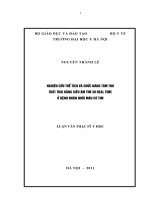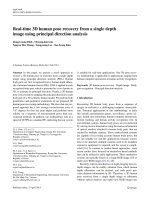handout real time intro
Bạn đang xem bản rút gọn của tài liệu. Xem và tải ngay bản đầy đủ của tài liệu tại đây (3.27 MB, 262 trang )
An Introduction to Real-Time Operating Systems and
Schedulability Analysis
Marco Di Natale
Scuola Superiore S. Anna
Outline
• Background on Operating Systems
• An Introduction to RT Systems
• Model-based development of Embedded RT systems
– the RTOS in the platform-based design
• Scheduling and Resource Management
• Schedulability Analysis and Priority Inversion
– The Mars Pathfinder case
• Implementation issues and standards
– OSEK
Credits
•
•
•
•
Paolo Gai (Evidence S.r.l.) – slides on EDF and OSEK
Giuseppe Lipari (Scuola Superiore S. Anna) – slides on OS
Manas Saksena (TimeSys) – examples on blocking time comput.
From Mathworks Simulink and RTW manuals – slides on RT
blocks
Background on Operating Systems
Fundamentals
• Algorithm:
– It is the logical procedure to solve a certain problem
– It is informally specified a a sequence of elementary steps
that an “execution machine” must follow to solve the
problem
– It is not necessarily expressed in a formal programming
language!
• Program:
– It is the implementation of an algorithm in a programming
language
– Can be executed several times with different inputs
• Process:
– An instance of a program that given a sequence of inputs
produces a set of outputs
Operating System
• An operating system is a program that
– Provides an “abstraction” of the physical machine
– Provides a simple interface to the machine
– Each part of the interface is a “service”
• An OS is also a resource manager
– The OS provides access to the physical resources of a
computing machine
– The OS provides abstract resources (for example, a file, a
virtual page in memory, etc.)
Levels of abstraction
User Level
Programmer
Level
Kim
Lisa
Web
Browser
Shell
System
Level
Bill
Videogame
Printer
Daemon
Interface (System API)
Operating
System
Virtual Memory
Device
Driver
Device
Driver
Scheduler
Device
Driver
Device
Driver
Virtual File Sys.
Device
Driver
Device
Driver
HW Level
Main Board
CPU
Keyboard
Network Card
Printer
Video Card
Printer
Hard disk
Abstraction mechanisms
• Why abstraction?
– Programming the HW directly has several drawbacks
• It is difficult and error-prone
• It is not portable
– Suppose you want to write a program that reads a text file
from disk and outputs it on the screen
• Without a proper interface it is virtually impossible!
Abstraction Mechanisms
• Application programming interface (API)
– Provides a convenient and uniform way to access to one
service so that
• HW details are hidden to the high level programmer
• One application does not depend on the HW
• The programmer can concentrate on higher level tasks
– Example
• For reading a file, linux and many other unix OS provide the
open(), read() system calls that, given a “file name” allow to
load the data from an external support
the need for concurrency
• there are many reason for concurrency
– functional
– performance
– expressive power
• functional
– many users may be connected to the same system at the
same time
• each user can have its own processes that execute
concurrently with the processes of the other users
– perform many operations concurrently
• for example, listen to music, write with a word processor, burn a
CD, etc...
• they are all different and independent activities
• they can be done “at the same time”
the need for concurrency (2)
• performance
– take advantage of blocking time
• while some thread waits for a blocking condition, another thread
performs another operation
– parallelism in multi-processor machines
• if we have a multi-processor machine, independent activities can be
carried out on different processors are the same time
• expressive power
– many control application are inherently concurrent
– concurrency support helps in expressing concurrency, making
application development simpler
theoretical model
• a system is a set of concurrent activities
– they can be processes or threads
• they interact in two ways
– they access the hardware resources
• processor
• disk
• memory, etc.
– they exchange data
• these activities compete for the resources and/or
cooperate for some common objective
Process
• The fundamental concept in any operating system
is the “process”
– A process is an executing program
– An OS can execute many processes at the same time
(concurrency)
– Example: running a Text Editor and a Web Browser at the
same time in the PC
• Processes have separate memory spaces
– Each process is assigned a private memory space
– One process is not allowed to read or write in the memory
space of another process
– If a process tries to access a memory location not in its
space, an exception is raised (Segmentation fault), and
the process is terminated
– Two processes cannot directly share variables
Memory layout of a Process
Other data
Heap
Stack
BSS
Initialized Data
Text
Dynamically allocated
Dynamically allocated
memory
memory
(variable size)
(variable size)
Stack
Stack
(variable size)
(variable size)
Global variables
Global variables
(non initialized)
(non initialized)
Global variables
Global variables
(initialized)
(initialized)
Contains the process code
Contains the process code
(machine code)
(machine code)
Memory Protection
• By default, two processes cannot share their
memory
– If one process tries to access a memory
location outside its space, a processor
exception is raised (trap) and the
process is terminated
– The “Segmentation Fault” error!!
Any reference to this
Any reference to this
memory results in a
memory results in a
segmentation fault
segmentation fault
Other data
Heap
Stack
BSS
Initialized Data
Text
Processes
• We can distinguish two aspects in a process
• Resource Ownership
– A process includes a virtual address space, a process image
(code + data)
– It is allocated a set of resources, like file descriptors, I/O
channels, etc
• Scheduling/Execution
– The execution of a process follows an ececution path, and
generates a trace (sequence of internal states)
– It has a state (ready, Running, etc.)
– And scheduling parameters (priority, time left in the round, etc.)
Multi-threading
• Many OS separate these aspects, by providing the
concept of thread
• The process is the “resource owner”
• The thread is the “scheduling entity”
– One process can consists of one or more threads
– Threads are sometime called (improperly) lightweight
processes
– Therefore, on process can have many different (and
concurrent) traces of execution!
Multi-threaded process model
• In the multi-threaded
process model each
process can have many
threads
–
–
–
–
One address space
One PCB
Many stacks
Many TCB (Thread
Control blocks)
– The threads are
scheduled directly by the
global scheduler
Process
control
block
Process
address
space
Process
Process
Thread
Thread
Thread
Thread
Thread
Thread
Thread
control
block
Thread
control
block
Thread
control
block
User
stack
User
stack
User
stack
Kernel
stack
Kernel
stack
Kernel
stack
Threads
• Generally, processes do not share memory
– To communicate between process, it is necessary to user
OS primitives
– Process switch is more complex because we have to
change address space
• Two threads in the same process share the same
address space
– They can access the same variables in memory
– Communication between threads is simpler
– Thread switch has less overhead
Threads support in OS
• Different OS implement threads in different ways
– Some OS supports directly only processes
• Threads are implemented as “special processes”
– Some OS supports only threads
• Processes are threads’ groups
– Some OS natively supports both concepts
• For example Windows NT
• In Real-Time Operating Systems
– Depending on the size and type of system we can have
both threads and processes or only threads
– For efficiency reasons, most RTOS only support
• 1 process
• Many threads inside the process
• All threads share the same memory
– Examples are RTAI, RT-Linux, Shark, some version of
VxWorks, QNX, etc.
The thread control block
• In a OS that supports threads
– Each thread is assigned a TCB (Thread Control Block)
– The PCB holds mainly information about memory
– The TCB holds information about the state of the thread
Thread Table
TID
PID
CR
IP
SP
Other Reg.
State
Priority
Time left
...
Thread states
• The OS can execute many threads at the same time
• Each thread, during its lifetime can be in one of the following
states
–
–
–
–
–
Starting
Ready
Executing
Blocked
Terminating
(the thread is being created)
(the thread is ready to be executed)
(the thread is executing)
(the thread is waiting on a condition)
(the thread is about to terminate)
Thread states
a)
b)
c)
d)
e)
f)
Creation
Dispatch
Preemption
Wait on condition
Condition true
Exit
The thread is created
The thread is selected to execute
The thread leaves the processor
The thread is blocked on a condition
The thread is unblocked
The thread terminates
b
Start
a
Ready
Running
c
e
Blocked
f
d
Terminate
Thread queues
Ready queue
Admit
Dispatch
CPU
Preemption
Event occurs
Wait condition 1
Event occurs
Wait condition 2
Event occurs
Wait condition 3
Context switch
• It happens when
– The thread has been “preempted” by another higher priority
thread
– The thread blocks on some condition
– In time-sharing systems, the thread has completed its “round”
and it is the turn of some other thread
• We must be able to restore the thread later
– Therefore we must save its state before switching to another
thread









